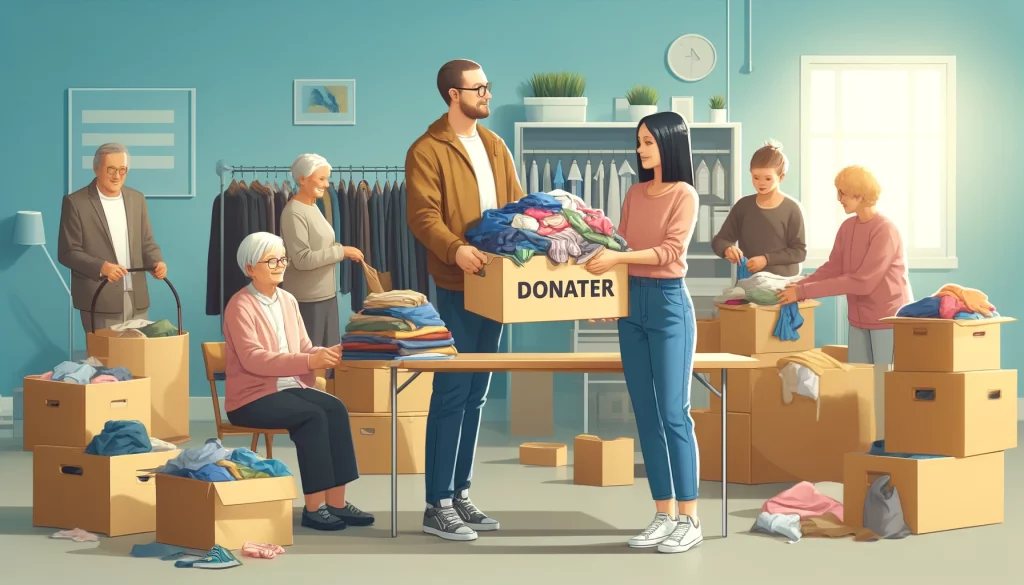
Clearing out your closet can feel refreshing, but figuring out what to do with those bags of unwanted clothes can be overwhelming. Many of us want to donate our old items but aren’t sure how to do it responsibly. Our guide provides insight on how to donate clothes the responsible way. We’ll cover everything from sorting and preparing your items for donation to finding alternative ways to repurpose or recycle them if they’re not suitable for donation.
By following these steps, you contribute positively both to people in need and the environment. Keep reading for all you need to know about responsible clothing donation.
Key Takeaways
- Donating clothes should be done responsibly by ensuring they are clean, undamaged, and sorted. This helps charities distribute items more efficiently.
- Explore alternative ways to donate like reselling, repairing, or recycling through retailers and third-party programs to support sustainable fashion.
- Choose reputable local thrift stores, charities, or donation centers for your contributions to make a positive impact on the environment and aid those in need.
How to Responsibly Donate Clothes

Donating clothes responsibly means ensuring they are clean and in good condition. It involves choosing the right place that can make the best use of your items.
The Do’s and Don’ts of Donating Clothes
Choosing to donate clothes is a great way to declutter your home and support charitable causes. It’s important to follow certain guidelines to ensure your donations are beneficial.
Do’s of Donating Clothes:
- Pick reputable charities for clothing donations, aiming to reduce landfill waste.
- Verify what items donation centers accept before dropping off your clothes.
- Only donate gently used clothes that are still in wearable condition.
- Make sure all clothing is clean and ready for immediate use by others.
- Declutter and organize your space by donating clothes, which aids organizations depending on such contributions.
- Consider the environmental and social benefits of donating clothes, like promoting sustainable fashion.
Don’ts of Donating Clothes:
- Avoid giving away clothes that are dirty or damaged beyond repair.
- Do not assume all places will take every kind of item; always check first.
- Refrain from dropping donations off outside closed facilities or bins, as this can create problems for the organization.
- Resist the urge to donate just for the sake of decluttering without considering quality and usability.
Following these simple guidelines ensures your contributions offer value to secondhand stores, charitable organizations, and individuals in need while supporting environmental sustainability through textile recycling.
Sorting Through Your Items
Start by decluttering your closet to identify clothes you no longer wear or need. Make two piles: one for clothes in good condition and another for those that are worn out. Donating only the items that are clean, undamaged, and wearable contributes positively to charitable giving.
“Sorting and labeling items before donating makes the process easier for charity workers.”
Next, organize the wearable clothes by type – shirts with shirts, pants with pants – then place them in separate boxes or bags. Label each container clearly indicating its contents.
This extra step supports community support efforts by streamlining the sorting process at donation centers.
Now let’s move on to how we should clean and prepare these items for donation.
Cleaning and Preparing Your Clothes for Donation
Check each clothing item for stains, tears, or missing buttons. Fix these issues to ensure your clothes are in good shape. Wash all items before donating them. This shows respect to those who will receive your clothes.
Pack your cleaned and repaired clothes neatly. Use bags or boxes for easy transportation. Label these packages clearly if the donation center requests it. Dropping off clean, prepared clothes helps charities sort and distribute donations efficiently.
Alternative Ways to Donate Clothes

Exploring different methods of donating clothes can make a significant impact. From reselling for a cause to recycling with purpose, the options extend beyond traditional drop-offs.
Reselling and Consigning
Reselling and consigning clothes offers a smart way to clear out your wardrobe while benefiting both the environment and your wallet. Shops that specialize in secondhand clothing welcome preowned fashion, giving items a new life instead of heading to landfill.
You can earn back some cash by reselling clothes or opt for consignment stores where you get paid once your item sells. It’s an effective method to support sustainable fashion.
“Anything left over from outlets is sold in bulk as salvage and sorted into categories such as resale or recycling.”
This practice not only helps in reducing waste but also supports the market for upcycled and thrifted goods. By choosing to resell or consign, you contribute to the cycle of clothing rehoming, ensuring less strain on natural resources used in producing new garments.
Repairing and Repurposing
Repairing and repurposing old clothes breathe new life into them, making these practices essential for sustainable clothing. Fixing a tear or transforming styles turns unwanted garments into treasured items.
This approach not only extends the life of clothes but also plays a crucial role in cutting down textile waste that ends up in landfills.
Upcycling is another creative way to repurpose textiles, offering an ecofriendly fashion solution. By turning old clothes into bags, quilts, or other items, we contribute to a circular economy and support sustainable fashion practices.
This shifts us away from disposable consumer habits towards more responsible choices that favor clothing reuse and reduce our environmental footprint.
Recycling Through Retailers
Many retailers now offer programs for recycling old clothes, targeting a reduction in textile waste and promoting sustainable fashion. These stores accept worn-out or used clothing from any brand, turning them into new items or recycling them responsibly.
This helps keep textiles out of landfills and supports the circular economy, making it an eco-friendly option for disposal.
Next up is recycling through third-party programs, which provide another avenue to ensure your unwanted garments are handled sustainably.
Recycling Through Third-party Programs
Recycling through third-party programs offers a sustainable fashion choice for ecofriendly clothing donation. Third-party services collect old clothes, textiles for reuse, and upcycling.
They provide bins in public places or offer mail-in options. This makes it easy to recycle clothes that are no longer wearable. These programs help keep textiles out of landfills and support the secondhand clothing market.
“Textile recycling turns old into new, making every piece count towards a more sustainable future.”
Where to Donate Clothes

Local thrift stores and charities welcome your clothes. Donation centers and clothing pickup options make giving easy.
Local Thrift Stores and Charities
Shops like Out of the Closet and Savers not only offer a second life to your clothes but also support good causes with their earnings. They are among the many local thrift stores and charitable organizations eager for clothing donations.
These places make it easy to give back to the community while clearing out your closet. Goodwill is another key player, selling approximately 30 percent of its donations locally through various channels, including thrift stores and online platforms.
Donating here means your old favorites can find new homes while helping fund social programs.
Now let’s move on to other donation options such as donation centers, where dropping off clothes is quick and supports multiple charitable activities.
Donation Centers
Moving from local thrift stores and charities, donation centers offer another great option for clothing donations. These centers specifically cater to collecting and redistributing clothes to those in need.
They ensure that your items reach people who can truly benefit from them. Many reputable donation centers work hard to prevent donated clothes in poor condition from ending up in landfills.
National and local organizations like the American Red Cross and Becca’s Closet welcome your donations with open arms. Before dropping off your clothes, it’s good practice to check what items they are currently accepting.
This step helps make sure your contribution is as helpful as possible. Donation centers play a crucial role in extending the lifespan of reusable clothing and supporting sustainable fashion efforts globally.
Clothing Donation Pickup Options
Many charities, including Salvation Army, Goodwill, AMVETS, The Arc, and Habitat for Humanity offer free clothing donation pickup services. This makes donating clothes convenient for those with busy schedules or large items to donate.
You simply schedule a pickup time and leave your bags of gently used clothing outside your home.
For bigger donations like furniture in addition to clothing, most of these organizations will pick up those as well at no cost. Explore local thrift stores and charitable organizations offering free pickup for donations near you.
These services help get your items directly to people in need or support vital community programs through the sale of donated goods.
Next, let’s discuss where to drop off your clothes if pickup service is not your preferred option.
Conclusion
Donating clothes responsibly helps clear out your space and aids those in need. Clean, sort, and prep your items to make sure they meet charity guidelines. Consider reselling, repurposing, or recycling as alternative ways to give.
Choose reputable local charities or donation centers for your contributions. Your efforts create a positive impact on the environment and support sustainable fashion practices.
FAQs
1. How do I choose where to donate my clothes?
Pick a charity or organization that matches your values and checks if they accept clothing donations.
2. What condition should my clothes be in for donation?
Your clothes should be clean and in good condition, free from tears or stains.
3. Can I donate old underwear or socks?
No, it’s best not to donate used underwear or socks unless they are new and still in their packaging.
4. Should I wash the clothes before donating them?
Yes, always wash the clothes you plan to donate first.
5. Is there anything I shouldn’t donate?
Avoid donating damaged clothing, as most organizations cannot use them.